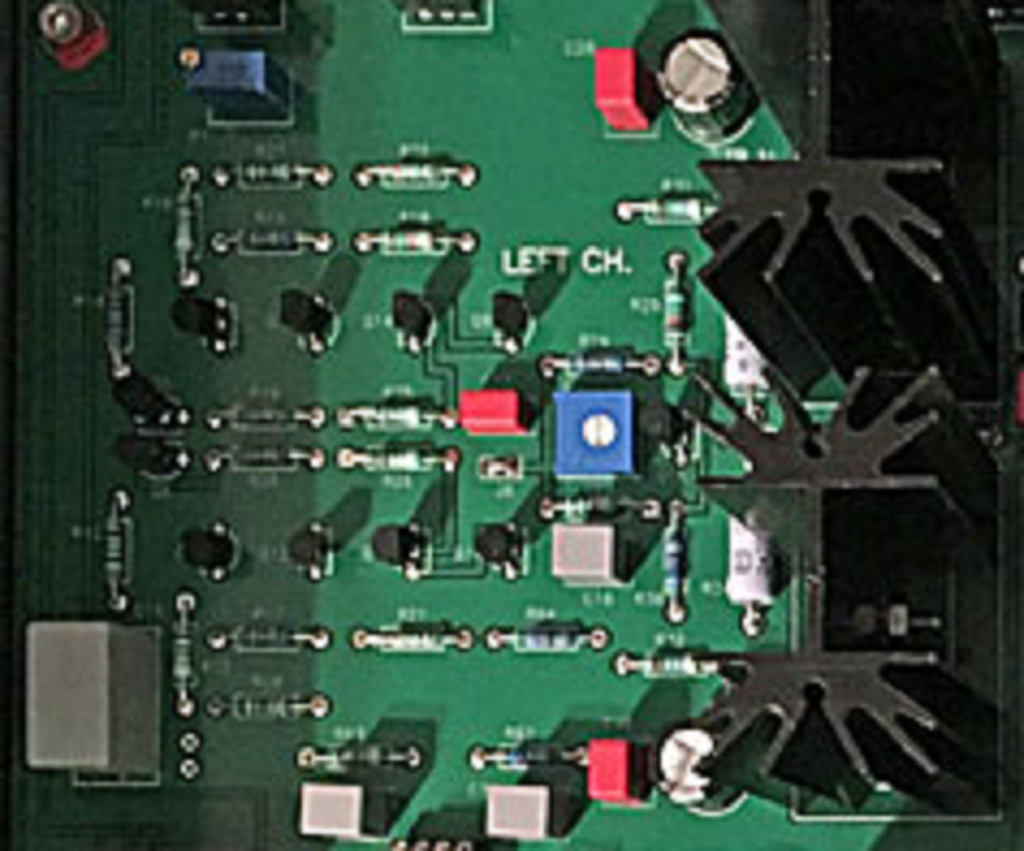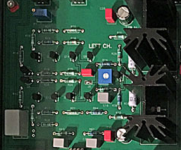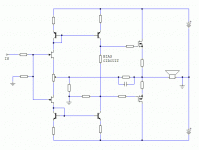Pass' new HPA-1 is certainly getting good press.
Pass Labs HPA-1 headphone amplifier | Stereophile.com
Do we know anything about the design? Push-Pull or single-ended? Based on any currently known topology (Aleph, etc.)?
Just trying to figure out what Pass considers the best approach for headphone amplification.
Pass Labs HPA-1 headphone amplifier | Stereophile.com
Do we know anything about the design? Push-Pull or single-ended? Based on any currently known topology (Aleph, etc.)?
Just trying to figure out what Pass considers the best approach for headphone amplification.
A picture is worth a thousand words...
Zooming in on the left channel, I see 12 active devices in a very symmetric layout. It looks like 10 actives prior to the two big output MOSFETs with large 3w source resistors. I see one DC offset trimpot, 1 bias trimpot. There is a TO92 programmable voltage source (TLM431?) providing bias current adjustment, it's not in the audio path. The opamp is in between the two channels and I don't think it is in the audio path either.

I suspect it might be a push-pull output stage with something resembling one of Juma's creations.
An externally hosted image should be here but it was not working when we last tested it.
Zooming in on the left channel, I see 12 active devices in a very symmetric layout. It looks like 10 actives prior to the two big output MOSFETs with large 3w source resistors. I see one DC offset trimpot, 1 bias trimpot. There is a TO92 programmable voltage source (TLM431?) providing bias current adjustment, it's not in the audio path. The opamp is in between the two channels and I don't think it is in the audio path either.

I suspect it might be a push-pull output stage with something resembling one of Juma's creations.
Attachments
Last edited:
The op amp is likely a servo. Some of the to-92 active devices may be regulators or voltage references. Probably push pull I would imagine. Still would like to know more...
The big film caps are curious if they are not rail decoupling.
The big film caps are curious if they are not rail decoupling.
Current feedback design by the looks of it.
Something like one of our great minds here has already offered on the topc of another Pass designs, just this one is sized for headphones. Here is the link.
http://www.diyaudio.com/forums/pass-labs/299383-pass-xa25-4.html#post4891894
Something like one of our great minds here has already offered on the topc of another Pass designs, just this one is sized for headphones. Here is the link.
http://www.diyaudio.com/forums/pass-labs/299383-pass-xa25-4.html#post4891894
> Do we know anything about the design?
More than you need to reverse engineer it, even down to component level.
Read the 6moon review in detail, not only the pictures.
> Push-Pull or single-ended?
Single-ended (as opposed to balanced) push-pull.
> Based on any currently known topology (Aleph, etc.)?
No.
> 5 pairs = 4 beasts and a cascode?
6moon :
"...... I tried different devices including bipolars and in the final analysis we chose Toshiba Jfets for the input stage,
Fairchild Mosfets for the outputs and bipolars in the current mirrors so we ended up using all three device types.....
the voltage gain occurs in the Jfet/mirror stage and the Mosfets provide the current drive....."
Patrick
More than you need to reverse engineer it, even down to component level.
Read the 6moon review in detail, not only the pictures.
> Push-Pull or single-ended?
Single-ended (as opposed to balanced) push-pull.
> Based on any currently known topology (Aleph, etc.)?
No.
> 5 pairs = 4 beasts and a cascode?
6moon :
"...... I tried different devices including bipolars and in the final analysis we chose Toshiba Jfets for the input stage,
Fairchild Mosfets for the outputs and bipolars in the current mirrors so we ended up using all three device types.....
the voltage gain occurs in the Jfet/mirror stage and the Mosfets provide the current drive....."
Patrick
Last edited:
> Do we know anything about the design?
More than you need to reverse engineer it, even down to component level.
Read the 6moon review in detail, not only the pictures.
> Push-Pull or single-ended?
Single-ended (as opposed to balanced) push-pull.
> Based on any currently known topology (Aleph, etc.)?
No.
> 5 pairs = 4 beasts and a cascode?
6moon :
"...... I tried different devices including bipolars and in the final analysis we chose Toshiba Jfets for the input stage,
Fairchild Mosfets for the outputs and bipolars in the current mirrors so we ended up using all three device types.....
the voltage gain occurs in the Jfet/mirror stage and the Mosfets provide the current drive....."
Patrick
Sound like this one: http://gilmore.chem.northwestern.edu/lc.pdf
Thanks, Juma.
Component values? I assume sk170/sj74 and BC550/560's then IRF610 and IRF9610 are good?
Can TL431 and a pot and resistor be used for bias circuit?
Component values? I assume sk170/sj74 and BC550/560's then IRF610 and IRF9610 are good?
Can TL431 and a pot and resistor be used for bias circuit?
In is a current feedback design, the IC is used as a servo and Juma is on the right track.
Circuit design aside part of the key is the custom transformer, which surprised me in the design phase on how much transformers affect the final sound. 🙂
Jam
Circuit design aside part of the key is the custom transformer, which surprised me in the design phase on how much transformers affect the final sound. 🙂
Jam
Last edited:
part of the key is the custom transformer, which surprised me in the design phase on how much transformers affect the final sound. 🙂
Jam
Due to conducted and radiated noise or other properties?
To some degree. I went through about seven prototypes before I decided. The construction was important as well.
The construction was important as well.
 The construction was important as well.
The construction was important as well.To some degree. I went through about seven prototypes before I decided.The construction was important as well.
So you're saying if you tell me you'd have to kill me?
Hahahaha
Micheal,
I have tried some R-cores before and they are quite good but I have found that a properly designed toroid is as good and has some advantages.
I have tried some R-cores before and they are quite good but I have found that a properly designed toroid is as good and has some advantages.
Last edited:
Hi Zen Mod,
I agree with you completely, but with the HPA-1 heat would have been an issue. I have a pre-amp prototype that I am working on that uses a shunt. I run about 1.5 time more current through the shunt than through the circuit for best sound.
A pic
I agree with you completely, but with the HPA-1 heat would have been an issue. I have a pre-amp prototype that I am working on that uses a shunt. I run about 1.5 time more current through the shunt than through the circuit for best sound.
A pic
Attachments
Last edited:
- Home
- Amplifiers
- Pass Labs
- Pass HPA-1, what do we know?



